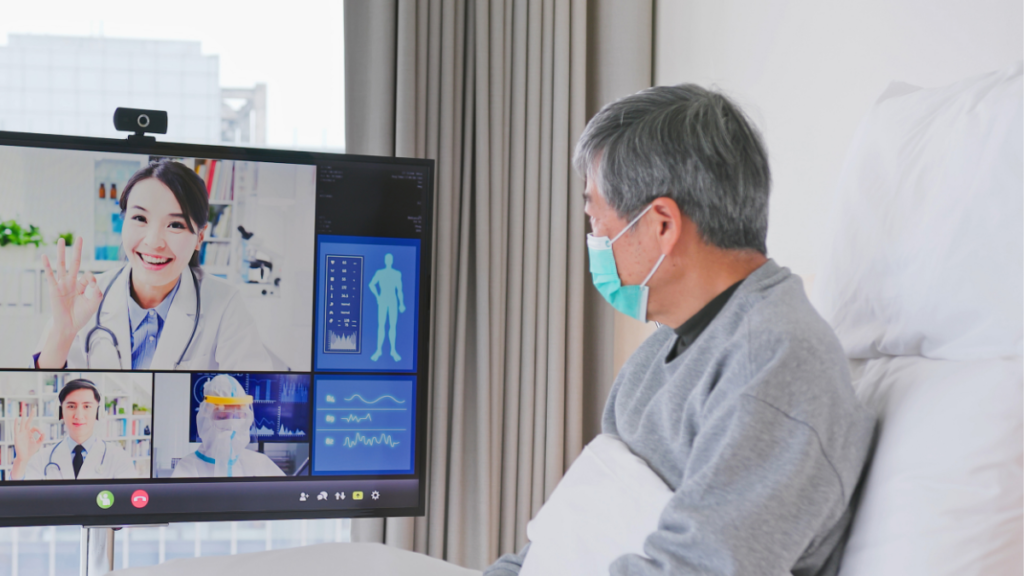SHARE

What Is Telehealth? 10 Life-Changing Benefits You Need to Know Today

What is telehealth? It’s a modern way to solve healthcare problems by letting people get medical help from a distance using technology. Whether it’s a follow-up consultation or mental health support, telehealth services offer convenience, accessibility, and real-time interaction.
To make telehealth even more efficient, many providers rely on advanced healthcare IT services that ensure secure, reliable, and seamless digital care delivery.
In this article, we’ll break down how does telehealth work, explain what is a telehealth appointment, and walk you through 10 meaningful, real-life benefits of this growing healthcare method. Whether you’re a patient or a healthcare provider, understanding telehealth can help you make smarter, faster decisions about care.
Table of Contents
What Is Telehealth?

Telehealth is a way for patients and doctors to talk and share information using technology like video calls, phone calls, or secure apps. Instead of going to a clinic or hospital, patients can get medical advice, prescriptions, or follow-ups from home.
It’s more than just a phone call; telehealth includes tools that let doctors monitor conditions, send reports, and maintain medical records electronically. It works for many services: routine check-ups, mental health counseling, medication management, and even physical therapy follow-ups.
This method is especially helpful for people in remote areas, busy individuals, or those who can’t easily travel due to age, illness, or diverse abilities.
What Is a Telehealth Appointment?
A telehealth appointment is a scheduled virtual meeting between a healthcare provider and a patient. It’s similar to an in-person visit, but it happens through a secure video call or over the phone.
During the appointment, you can:
- Discuss symptoms
- Share medical history
- Show visible symptoms (like rashes or swelling) on video
- Receive medical advice and prescriptions
- Get referrals to specialists if needed
For many people, these appointments feel more relaxed because they take place at home. As long as you have a device with internet access, you’re ready for a telehealth appointment.
How Does Telehealth Work?
How does telehealth work? It’s surprisingly simple:
- Book Your Appointment: Either online or over the phone through your healthcare provider.
- Receive Confirmation: You’ll get a message or email with a secure link and time.
- Prepare Your Device: Use a smartphone, tablet, or computer with a camera and microphone.
- Join the Meeting: At the scheduled time, click the link and wait for your provider to join.
- Talk Just Like You Would In Person: Your provider can ask questions, offer treatment, and send a digital prescription if necessary.
Telehealth systems are designed with privacy in mind. Most use encrypted video platforms that follow healthcare regulations like HIPAA.
Learn how digital health records enhance virtual care in our guide on EHR software.
10 Life-Changing Benefits of Telehealth

1. Better Access for Remote and Rural Areas
Many people live far from hospitals or specialists. With telehealth, patients in small towns or rural regions can connect with top doctors, saving time and improving health outcomes.
2. Faster Medical Attention
Getting a same-day appointment is easier with telehealth. Instead of waiting days or weeks, patients can speak with a doctor quickly, sometimes in just minutes.
3. Lower Healthcare Costs
A major benefit of telehealth is cost. Patients don’t spend on travel, childcare, or parking. Providers also save by reducing overhead for physical office space.
4. Ongoing Care for Chronic Conditions
Conditions like diabetes, heart disease, or asthma need regular care. Telehealth makes it easier to schedule follow-ups and medication adjustments without needing to visit a clinic every time.
5. Mental Health Support That Feels Safe
Virtual therapy helps patients open up in a familiar setting like their bedroom or home office. It also removes the fear of being seen entering a mental health clinic.
6. Lower Risk of Catching or Spreading Illness
For people with weakened immune systems or during outbreaks (like COVID-19), telehealth means you can get help without risking exposure in a hospital waiting room.
7. Access to Specialists Without Travel
Do you need a second opinion or a specific type of care? Telehealth lets you talk to specialists in different cities or countries, enlarging your options.
8. Improved Follow-Up and Recovery
After surgeries or procedures, quick check-ins through telehealth ensure patients recover properly. Doctors can monitor wounds or side effects using video.
9. Flexible Scheduling for Busy Lives
Balancing work, school, and family can be tough. Telehealth offers evening or weekend slots and lets you talk to a doctor without rearranging your whole day.
10. Increased Patient Involvement
When patients use telehealth tools to check lab results, monitor blood pressure, or message their doctor, they stay more involved in their care, and that leads to better outcomes.
Comparison Table: Telehealth vs Traditional Care
| Feature | Telehealth | Traditional Healthcare |
|---|---|---|
| Travel Time | None -appointment from anywhere | Required – must visit clinic or hospital |
| Waiting Room | No waiting room needed | Wait time before seeing the doctor |
| Flexibility | High – schedule based on your availability | Limited to clinic hours |
| Specialist Access | Easily available through networks | Might require long-distance travel |
| Risk of Infections | Very low | Higher risk in crowded facilities |
| Follow-Up Visits | Quick and simple | Time-consuming and harder to schedule |
| Cost | Often more affordable | Includes travel and overhead expenses |
What is telehealth appointments best for?
Telehealth appointments are great for many healthcare needs, such as:
- Cold or flu symptoms
- Skin rashes or allergies
- Therapy and mental health
- Birth control or UTI treatments
- Monitoring diabetes or hypertension
- Discussing lab results
They’re not always the best option for emergency care, broken bones, or procedures requiring physical tests, but they work well for most everyday health issues.
Who Can Use Telehealth?
Anyone who has a phone, tablet, or computer can use telehealth services. It works across age groups and is especially useful for:

- Seniors needing a routine checkups
- Parents caring for sick children
- College students away from home
- Working professionals with limited time
Healthcare providers also benefit; they can see more patients, reduce no-shows, and deliver more personalized care.
Conclusion: Ready to Make Telehealth Work for You?
Telehealth is more than a trend; it’s a reliable way to receive care faster, easier, and from anywhere. Whether you’re dealing with everyday symptoms or managing a chronic illness, telehealth appointments offer a practical solution.
If you’ve ever wondered, what is telehealth? or asked yourself how it works, this guide should help you feel confident using it. With the growing demand for flexible care, telehealth is not just a convenience. It’s becoming essential.
At Diligentic Infotech, we help healthcare providers adopt secure, easy-to-use telehealth solutions. Whether you’re a clinic looking to expand or a startup building a telehealth platform, we’re ready to support you.
👉 Let’s talk and bring your healthcare services online with confidence.
FAQs
What is telehealth?
Telehealth is the use of digital platforms to provide healthcare services remotely.
Can I still use telehealth if I’m not good with technology?
Yes, most platforms are user-friendly. Many also offer support to help you join your appointment easily.
What do I do if I miss my telehealth appointment?
Contact your provider immediately; they may offer a reschedule or charge a missed-visit fee.
Are telehealth consultations private and secure?
Yes, trusted platforms use encryption and comply with HIPAA or similar privacy laws to protect your data.
Is telehealth available 24/7?
Some providers offer round-the-clock care, especially for urgent needs; check your provider’s hours.
Engage with our experts
Subscribe to our newsletter!
Be the first to get exclusive offers and the latest news.
Posted on 10 Jun 2025
5 Common Mistakes Hospitals Make Without a Healthcare System
Running a hospital without a structured healthcare system is like managing traffic without signals that are cluttered and turn to critical errors. In healthcare, even small inefficiencies can lead to major consequences, not just for hospital operations but also for patient safety and satisfaction.
Posted on 12 Jun 2025
7 Shocking Truths About How IT Companies Are Revolutionizing EHR Software for Healthcare
EHR software is no longer just a digital replacement for paper files. It has become the engine behind smarter, faster, and more personalized patient care. IT companies are not only updating electronic health records; they’re reimagining how healthcare operates.
Posted on 18 Jun 2025
5 Life-Changing Benefits That Electronic Health Records Offer
Electronic Health Records (EHRs) go beyond simply digitizing paper documents; they serve as essential tools that enhance the quality and efficiency of healthcare services. From improving patient safety to enabling remote care and reducing admin overhead, EHR systems are transforming how healthcare works.

Reach out
Let’s Start Together
We're a collective of high caliber designers, developers, creators, and geniuses. We thrive off bouncing your ideas and opinions with our experience to create meaningful digital products and outcomes for your business.
Phone Number
+1 (825) 760 1797
hello[at]diligentic[dot]com
